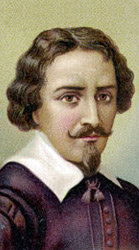Like many inventions today there are disputes in origins of the original inventors. The same dispute applies to who invented the microscope.
Dating back to the first century when glass was first invented, the Roman's were investigating the use of glass and how viewing objects through it, made the objects appear larger.
Then, in the 13th Salvino D'Armate from Italy, made the first eye glass, providing the wearer with an element of magnification to one eye.
The earliest simple forms of magnification were magnifying glasses, usually about 6x - 10x and were used for inspecting tiny insects such as fleas, hence these early magnifiers called "flea glasses".
Zacharias Jansen and the first compound microscope

Then, during the 1590's, two Dutch spectacle makers, Zacharias Jansen and his father Hans started experimenting with these lenses. They put several lenses in a tube and made a very important discovery. The object near the end of the tube appeared to be greatly enlarged, much larger than any simple magnifying glass could achieve by itself.
Their first microscopes were more of a novelty than a scientific tool since maximum magnification was only around 9x and the images were somewhat blurry. Although no Jansen microscopes survived, an instrument made for Dutch royalty was described as being composed of "3 sliding tubes, measuring 18 inches long when fully extended, and two inches in diameter". The microscope was said to have a magnification of 3x when fully closed, and 9x when fully extended.










